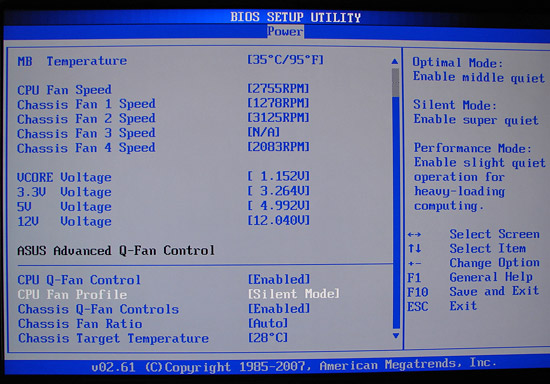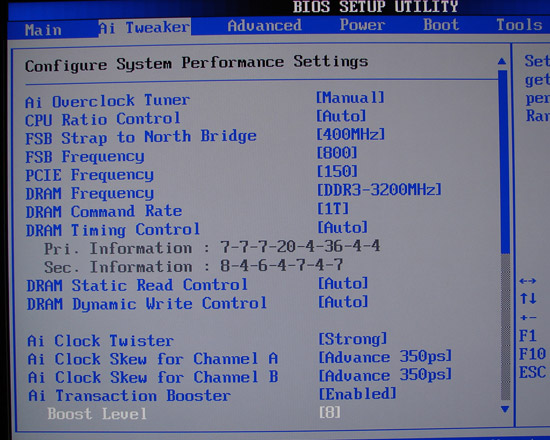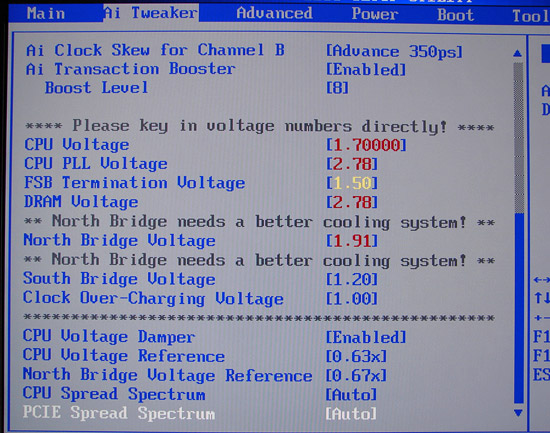ASUS P5E3 Deluxe: X38 and DDR3 arrives... almost
by Gary Key on September 18, 2007 4:00 AM EST- Posted in
- Motherboards
ASUS P5E3 Specifications and BIOS Overview
As mentioned, the P5E3 Deluxe board is designed for the general enthusiast with an emphasis on features designed for the home user, whether it is for gaming or home theater usage. ASUS provides two eSATA ports via the JMicron JMB363 chipset, IEEE-1394 support from Agere, excellent onboard audio support from the ADI 1988B, an 802.11n WiFi port, and dual Gigabit LAN capability. The board offers a very good mix of expansion slots, though utilizing a CrossFire setup will create the physical loss of a PCI-E x1 and PCI 2.2 slot. The third PCI-E x16 slot operates at x8 electrically and can be utilized for various PCI-E cards including AGEIA PhysX, RAID controllers, or a third video card. This slot will support a third ATI graphics card for "TriFire" operation once drivers are released with the proper support, according to our current information.
We will go into the BIOS settings in additional detail once we receive the retail kit and official launch BIOS. However, the following screenshots represent features that we know will be in the retail BIOS.

ASUS monitors the standard CPU fan speed and voltage readings. One item of note is that the BIOS monitors the CPU fan speed and four chassis headers but not the fifth header. Fan control is fairly limited when comparing it to abit's excellent uGuru setup with very simple options based on fan percentage speeds or base system temperatures. While the ability to individually control fan speeds is good, the speed options are too limited in our opinion for a board in the enthusiast category.

The advanced section of the BIOS contains the standard power saving options and an additional control for the CPU ratio.


The heart of the BIOS is under the AI Tweaker section with a wide variety of options for tuning the board. Although not as extensive as the typical DFI enthusiast boards, the options are fairly extensive with the notable addition being the 400FSB Strap setting in addition to 200, 266, and 333. Although not shown, the DRAM timing control section offers 15 different memory settings and hopefully they will remain in the retail BIOS.
ASUS has added the Ai Clock Twister option which basically offers slightly tighter sub-timings when set to strong. We noticed a slight decrease in latencies when utilizing this particular setting, but no tangible real world results that would matter to most users. ASUS has also revamped the Ai Transaction Booster setting when compared to their P35 boards. The old Transaction Booster setting of 0 on the P35 board is now 1 on the X38 board with the remaining ratios offering the same offset. Ratios 5 through 8 are new to the board although we could not get the board to POST with a ratio higher than 3.
Our screenshots show the maximum value for each option. Any setting greater than 1.77V for the Northbridge resulted in a warning for better chipset cooling. Although previous engineering samples of the X38 ran warm to hot when overclocking, our current sample stayed around 74C with 1.91V after two hours of looping 3DMark06. The available voltage options should satisfy about 95% of the users; however, we feel like the available CPU voltages are lacking when compared to the other X38 boards we have in-house as well as some of the upper-end P35 boards. ASUS has also included the ability to save BIOS profiles, although it is currently limited to two profiles.
| ASUS P5E3 Deluxe | |
| Market Segment | High Performance Enthusiast - $259.99 (estimated) |
| CPU Interface | Socket T (Socket 775) |
| CPU Support | LGA775-based Core 2 Duo, Core 2 Extreme, or Core 2 Quad Recommended |
| Chipset | Intel X38 (MCH) Northbridge and ICH9R Southbridge |
| Front Side Bus Speeds | Auto, 200 ~ 800 in 1MHz increments |
| DDR3 Memory Speed | Auto, Eight Ratios dependent upon Strap Setting |
| FSB Strap | Auto, 200, 266, 333, 400 |
| PCIe Speeds | Auto, 100MHz - 150MHz |
| PCI Speeds | Locked at 33.33MHz |
| Core Voltage | Auto, 1.10000 to 1.70000 in .00625 increments |
| CPU Clock Multiplier | 6x ~ 11x, downward adjustable for Core 2, upward to 50 for Extreme |
| DRAM Voltage DDR3 | Auto, 1.50V ~ 2.78V in .02V increments, 1.50V standard |
| DRAM Timing Control | Auto, Manual - 16 DRAM Timing Options (tCL, tRCD, tRP, tRAS, tRFC + 11 sub-timings) |
| DRAM Command Rate | Auto, 1T, 2T |
| NB Voltage | Auto, 1.25V ~ 1.91V in .02V increments, 1.25V standard |
| SB Voltage | Auto, 1.05V, 1.20V, 1.05 standard |
| FSB Termination Voltage | Auto, 1.20V to 1.50V in .02V increments, 1.20V standard |
| Clock Over Charging | Auto, .70V to 1.00V in .10V increments, .80 standard |
| CPU Voltage Damper | Auto, Enabled, Disabled |
| CPU Voltage Reference | Auto, .63, .61, .59, .57 |
| NB Voltage Reference | Auto, .67, .61 |
| AI Clock Twister | Auto, Light, Medium, Strong |
| AI Clock Skew CA/CB | Auto, Normal, 50ps to 350ps either advance or decrease |
| AI Transaction Booster | Auto, Enabled, Disabled, settings 1 to 8, higher increases performance |
| Memory Slots | Four 240-pin DDR3 DIMM Slots Dual-Channel Configuration Regular Unbuffered DDR3 Memory to 8GB Total |
| Expansion Slots | 3 - PCIe 2.0 x16 (2 - x16, 1 - x8 electrical) 2 - PCIe x1 2 - PCI Slot 2.2 |
| Onboard SATA/RAID | 6 SATA 3Gbps Ports - ICH9R (RAID 0,1, 10, 5) 2 eSATA 3Gbps Port - JMicron JMB363 |
| Onboard IDE | 1 ATA133/100/66 Port (2 drives) - JMicron JMB363 |
| Onboard USB 2.0/IEEE-1394 | 10 USB 2.0 Ports - 6 I/O Panel - 4 via Headers 2 Firewire 400 Ports by Agere FW3227 - 1 I/O Panel, 1 via Header |
| Onboard LAN | Realtek RTL8110SC - PCI Gigabit Ethernet controller Marvell 88E8056 PCI Express Gigabit Ethernet controller ASUS 802.11n Wireless Port |
| Onboard Audio | ADI 1988B - 8-channel HD audio codec |
| Power Connectors | ATX 24-pin, 8-pin ATX 12V |
| I/O Panel | 1 x PS/2 Keyboard 2 x eSATA 2 x SPDIF - Optical Out, Coaxial Out 1 x IEEE 1394 1 x Audio Panel 2 x RJ45 6 x USB 2.0/1.1 |
| Fan Headers | 6 - CPU, (5) Chassis |
| Fan Control | CPU and Chassis Fan Control via BIOS/AI Suite, PC Probe II monitoring |
| BIOS Revision | v1.4 |
| Board Revision | v1.0 |
As mentioned, the P5E3 Deluxe board is designed for the general enthusiast with an emphasis on features designed for the home user, whether it is for gaming or home theater usage. ASUS provides two eSATA ports via the JMicron JMB363 chipset, IEEE-1394 support from Agere, excellent onboard audio support from the ADI 1988B, an 802.11n WiFi port, and dual Gigabit LAN capability. The board offers a very good mix of expansion slots, though utilizing a CrossFire setup will create the physical loss of a PCI-E x1 and PCI 2.2 slot. The third PCI-E x16 slot operates at x8 electrically and can be utilized for various PCI-E cards including AGEIA PhysX, RAID controllers, or a third video card. This slot will support a third ATI graphics card for "TriFire" operation once drivers are released with the proper support, according to our current information.
We will go into the BIOS settings in additional detail once we receive the retail kit and official launch BIOS. However, the following screenshots represent features that we know will be in the retail BIOS.

ASUS monitors the standard CPU fan speed and voltage readings. One item of note is that the BIOS monitors the CPU fan speed and four chassis headers but not the fifth header. Fan control is fairly limited when comparing it to abit's excellent uGuru setup with very simple options based on fan percentage speeds or base system temperatures. While the ability to individually control fan speeds is good, the speed options are too limited in our opinion for a board in the enthusiast category.

The advanced section of the BIOS contains the standard power saving options and an additional control for the CPU ratio.


The heart of the BIOS is under the AI Tweaker section with a wide variety of options for tuning the board. Although not as extensive as the typical DFI enthusiast boards, the options are fairly extensive with the notable addition being the 400FSB Strap setting in addition to 200, 266, and 333. Although not shown, the DRAM timing control section offers 15 different memory settings and hopefully they will remain in the retail BIOS.
ASUS has added the Ai Clock Twister option which basically offers slightly tighter sub-timings when set to strong. We noticed a slight decrease in latencies when utilizing this particular setting, but no tangible real world results that would matter to most users. ASUS has also revamped the Ai Transaction Booster setting when compared to their P35 boards. The old Transaction Booster setting of 0 on the P35 board is now 1 on the X38 board with the remaining ratios offering the same offset. Ratios 5 through 8 are new to the board although we could not get the board to POST with a ratio higher than 3.
Our screenshots show the maximum value for each option. Any setting greater than 1.77V for the Northbridge resulted in a warning for better chipset cooling. Although previous engineering samples of the X38 ran warm to hot when overclocking, our current sample stayed around 74C with 1.91V after two hours of looping 3DMark06. The available voltage options should satisfy about 95% of the users; however, we feel like the available CPU voltages are lacking when compared to the other X38 boards we have in-house as well as some of the upper-end P35 boards. ASUS has also included the ability to save BIOS profiles, although it is currently limited to two profiles.










60 Comments
View All Comments
strikeback03 - Thursday, September 20, 2007 - link
My question about the heatpipe cooling is related to this:So why are these companies creating cooling solutions that work best with inferior CPU cooling? The heatpipe towers and water certainly seem to be the best CPU cooling, but the board cooling system looks like it was designed to work with the stock Intel cooler.
mostlyprudent - Tuesday, September 18, 2007 - link
I couldn't be happier to see the passive heatpipe cooling. After reading the reports of the X38 being a "hot" chipset, I was worried that I would be back to screaming/failing little chipset fans...whew...thank goodness.n0nsense - Tuesday, September 18, 2007 - link
there always water cooling option. which i'm thinking about.One circuit for CPU, GPU, NB and SB (like Nautilus 500) + Termalright for mofsets should be perfect for sane overclocking and quiet PC.
Etern205 - Tuesday, September 18, 2007 - link
I guess what they mean by "upside down" is do not install into aBTX case?
n0nsense - Tuesday, September 18, 2007 - link
No, they meant that the only (the best) way to install this boards is when CPU socket located on the upper side.look at the picture of CS-718. in this case CPU socket is in the lowest part. This mean that hotest part of heatpipe system is higher then coolest. Heatpipe working the best when coolant vaporized at hotest part, then liquefied at coolest (radiators). Liquefied coolant should return somehow to the hotest part (chipset), and when motherboard "normally" this done by gravity. When the board installed in "upside-down" or horizontally, this SHOULD be done by capillaries, which are way less effective according to Asus support and wiki.
Etern205 - Tuesday, September 18, 2007 - link
I was right about this "do not install into a BTX case"The Enermax CS-718 supports ATX motherboards, but the design is based on the BTX specs.
On a correct ATX case, if the back of the case if facing you, then you will open the panel on the right. And when the opening is facing you the front will face to the right.
http://img221.imageshack.us/img221/2901/1015uh6.jp...">Image
As for BTX if it's place into the same position, then you will open the panel on the left, which is what the Enermax CS-718 is designed to be and when the opening is facing you the front will face to the left. http://img175.imageshack.us/img175/6379/1007xq2.jp...">Image
JarredWalton - Tuesday, September 18, 2007 - link
FYI, I deleted your (numerous) multiple posts. A little bit of patience goes a long way. Once or twice I can understand, but three sets of multiple posts? Hopefully that was just a weird error on the part of your system.n0nsense - Wednesday, September 19, 2007 - link
it is a problem with my computer @ work.I guess it's caused by Synergy.
Anyway, thank you for clearing my extra messages. It's sad that i can't remove or edit my own messages.
n0nsense - Wednesday, September 19, 2007 - link
it is a problem with my computer @ work.I guess it's caused by Synergy.
Anyway, thank you for clearing my extra messages. It's sad that i can't remove or edit my own messages.
8steve8 - Tuesday, September 18, 2007 - link
is the intel g35 chipset launching with the x38? if not, when will it launch?while the x38 doesnt offer much tangable to the users of p35 or 965p, especially those of us that are sane (ddr2 users), the g35 appears to offer a vastly improved 3d engine, and native hdmi support. "vastly improved" over the g965 and g33, which, for example, i can play warcraft3 at 1600x1200 w/full settings... this is onboard video... very impressive.